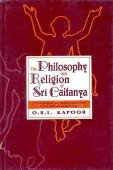Sampradaya, Sampradāya, Saṃpradāya: 19 definitions
Introduction:
Sampradaya means something in Hinduism, Sanskrit, Jainism, Prakrit, Marathi, Hindi. If you want to know the exact meaning, history, etymology or English translation of this term then check out the descriptions on this page. Add your comment or reference to a book if you want to contribute to this summary article.
Alternative spellings of this word include Sampraday.
Images (photo gallery)
In Hinduism
Vaishnavism (Vaishava dharma)
Source: ISKCON Press: GlossarySampradāya (सम्प्रदाय).—A disciplic succession of spiritual masters, along with the followers in that tradition, through which spiritual knowledge is transmitted; School of thought.
Source: Pure Bhakti: Bhagavad-gita (4th edition)Sampradāya (सम्प्रदाय) refers to “unbroken disciplic successive line transmitted from guru to disciple. Mantra is only effective when received in a bona fide sampradāya, of which there are four: Brahma, Śrī, Rudra and Sanaka”. (cf. Glossary page from Śrīmad-Bhagavad-Gītā).
Source: Pure Bhakti: Bhajana-rahasya - 2nd EditionSampradāya (सम्प्रदाय) refers to:—A line of disciplic succession. (cf. Glossary page from Bhajana-Rahasya).
Source: Pure Bhakti: Brhad BhagavatamrtamSampradāya (सम्प्रदाय) refers to:—A line of disciplic succession. (cf. Glossary page from Śrī Bṛhad-bhāgavatāmṛta).

Vaishnava (वैष्णव, vaiṣṇava) or vaishnavism (vaiṣṇavism) represents a tradition of Hinduism worshipping Vishnu as the supreme Lord. Similar to the Shaktism and Shaivism traditions, Vaishnavism also developed as an individual movement, famous for its exposition of the dashavatara (‘ten avatars of Vishnu’).
Shaktism (Shakta philosophy)
Source: Google Books: ManthanabhairavatantramSampradāya (सम्प्रदाय) refers to “(the teachings of the) tradition”, according to the Ambāmatasaṃhitā.—Accordingly, “[...] O Umā! Beloved of my life! Salutations, O mother of the universe! Be compassionate, O mistress of the universe! You who bestow the (teachings of the) tradition (sampradāya)! Salutations (to you) the nirvāṇa who saves me! You who give wealth, save and forgive! The previous Rule, which is the essence (of the teachings), was fashioned (by you) along with me. O bearer of the trident! explain the beneficial mantras (to me in a simple way) as (you would) to children. Originally, I myself told you the most excellent Yoga”.

Shakta (शाक्त, śākta) or Shaktism (śāktism) represents a tradition of Hinduism where the Goddess (Devi) is revered and worshipped. Shakta literature includes a range of scriptures, including various Agamas and Tantras, although its roots may be traced back to the Vedas.
In Jainism
Jain philosophy
Source: archive.org: Anekanta Jaya Pataka of Haribhadra SuriSampradāya (सम्प्रदाय) refers to “tradition”, as mentioned in the Anekāntajayapatākā-prakaraṇa, a Śvetāmbara Jain philosophical work written by Haribhadra Sūri.—[Cf. Vol. II, P. 238, l. 25]
-
Languages of India and abroad
Marathi-English dictionary
Source: DDSA: The Molesworth Marathi and English Dictionarysampradāya (संप्रदाय).—m (S) Custom, practice, usage: also a custom or a practice. 2 A phrase; an idiom; a speech or an expression in the popular or in a particular phraseology. 3 Traditional and authoritative doctrine. 4 Hence A system of religious doctrines, a persuasion.
--- OR ---
sāmpradāya (सांप्रदाय).—m (Common corruption of sampradāya) Custom or practice: also a custom or a practice. 2 A phrase or an idiom.
Source: DDSA: The Aryabhusan school dictionary, Marathi-Englishsampradāya (संप्रदाय).—m Custom. A phrase. A persuasion.
--- OR ---
sāmpradāya (सांप्रदाय).—m Custom, practice. A phrase.
Marathi is an Indo-European language having over 70 million native speakers people in (predominantly) Maharashtra India. Marathi, like many other Indo-Aryan languages, evolved from early forms of Prakrit, which itself is a subset of Sanskrit, one of the most ancient languages of the world.
Sanskrit dictionary
Source: DDSA: The practical Sanskrit-English dictionarySaṃpradāya (संप्रदाय).—
1) Tradition, traditional doctrine or knowledge, traditional handing down of instruction; चन्द्रकेतुरवाप्तदिव्यास्त्रसंप्रदायः (candraketuravāptadivyāstrasaṃpradāyaḥ) Uttararāmacarita 2.7/8; अथ तत् संप्रदायेन राम- भद्रे स्थिता अपि (atha tat saṃpradāyena rāma- bhadre sthitā api) 5.15.
2) A peculiar system of religious teaching, a religious doctrine inculcating the worship of one peculiar deity.
3) An established custom, usage.
4) Gift (saṃpradāna); दिव्यास्त्रसंप्रदायोऽयं लक्ष्मणेन सहास्तु मे (divyāstrasaṃpradāyo'yaṃ lakṣmaṇena sahāstu me) Mv.1.47. (Also cf. Uttararāmacarita 2.7/8.)
Derivable forms: saṃpradāyaḥ (संप्रदायः).
Source: Cologne Digital Sanskrit Dictionaries: Shabda-Sagara Sanskrit-English DictionarySampradāya (सम्प्रदाय).—m.
(-yaḥ) 1. Traditional doctrine, what has been transmitted from one teacher to another, and is established as of sacred authority. 2. A sect, a schism, a peculiar doctrine and exclusive worship of one divinity. 3. Custom, usage. E. sam and pra before dā to give, ghañ aff., yuk augment.
Source: Cologne Digital Sanskrit Dictionaries: Benfey Sanskrit-English DictionarySaṃpradāya (संप्रदाय).—i. e. sam-pra -dā + a, m. 1. Traditional doctrine, [Uttara Rāmacarita, 2. ed. Calc., 1862.] 39, 12 (datta-divya-astra-, adj. Possessed of the traditional knowledge of the celestial arms); [Rājataraṅgiṇī] 5, 139. 2. A peculiar doctrine and exclusive worship of one divinity.
Source: Cologne Digital Sanskrit Dictionaries: Cappeller Sanskrit-English DictionarySaṃpradāya (संप्रदाय).—[masculine] bestower; oral tradition.
Source: Cologne Digital Sanskrit Dictionaries: Monier-Williams Sanskrit-English Dictionary1) Sampradāya (सम्प्रदाय):—[=sam-pradāya] [from sampra-dā] m. a bestower, presenter, [Śārṅgadhara-paddhati]
2) [v.s. ...] tradition, established doctrine transmitted from one teacher to another, traditional belief or usage, [Gṛhya-sūtra and śrauta-sūtra] etc. etc.
3) [v.s. ...] any peculiar or sectarian system of religious teaching, sect, [Religious Thought and Life in India 61; 62]
Source: Cologne Digital Sanskrit Dictionaries: Yates Sanskrit-English DictionarySampradāya (सम्प्रदाय):—(yaḥ) 1. m. Traditional doctrine; a sect.
Source: DDSA: Paia-sadda-mahannavo; a comprehensive Prakrit Hindi dictionary (S)Saṃpradāya (संप्रदाय) in the Sanskrit language is related to the Prakrit word: Saṃpadāya.
[Sanskrit to German]
Sanskrit, also spelled संस्कृतम् (saṃskṛtam), is an ancient language of India commonly seen as the grandmother of the Indo-European language family (even English!). Closely allied with Prakrit and Pali, Sanskrit is more exhaustive in both grammar and terms and has the most extensive collection of literature in the world, greatly surpassing its sister-languages Greek and Latin.
Hindi dictionary
Source: DDSA: A practical Hindi-English dictionarySaṃpradāya (संप्रदाय) [Also spelled sampraday]:—(nm) a community; sect; ~[gata/paraka] communal; sectarian; ~[vāda] communalism; sectarianism; ~[vādī] (a) communalist; sectarian; •[dṛṣṭikoṇa] communal/sectarain outlook.
...
Kannada-English dictionary
Source: Alar: Kannada-English corpusSaṃpradāya (ಸಂಪ್ರದಾಯ):—
1) [noun] a social convention carried on by tradition and enforced by social disapproval of any violation; a custom.
2) [noun] a long-established religious custom or practice that has the effect of an unwritten law; a tradition.
3) [noun] a kind, manner, way (in which something is to be done, observed or is being done, observed, etc.).
4) [noun] a traditional school of thought (as in philosophy, religion, etc.).
--- OR ---
Sāṃpradāya (ಸಾಂಪ್ರದಾಯ):—
1) [noun] a social convention carried on by tradition and enforced by social disapproval of any violation; a custom.
2) [noun] a long-established religious custom or practice that has the effect of an unwritten law; a tradition.
3) [noun] a man following or advocating a particular custom or tradition.
Kannada is a Dravidian language (as opposed to the Indo-European language family) mainly spoken in the southwestern region of India.
See also (Relevant definitions)
Partial matches: Sam, Pradaya.
Starts with (+6): Sampradayacandrika, Sampradayakuladipika, Sampradayam, Sampradayanirupana, Sampradayanirupana tattvaprakriyatika, Sampradayanishtha, Sampradayanishthe, Sampradayapaddhati, Sampradayaparishuddhi, Sampradayapradipa, Sampradayapradipapaddhati, Sampradayapradyotaka, Sampradayaprakashini, Sampradayaprapta, Sampradayasharana, Sampradayasharane, Sampradayashuddha, Sampradayastha, Sampradayasthe, Sampradayatas.
Ends with: Agamasampradaya, Astrasampradaya, Bhagavatasampradaya, Devadasisampradaya, Devasampradaya, Karamalasampradaya, Kulasampradaya, Nagasampradaya, Nathasampradaya, Pathasampradaya, Rasasampradaya, Samashrayanasampradaya, Satsampradaya, Shastrasampradaya, Shishtasampradaya, Shishyasampradaya, Vaidikasampradaya, Yakshasampradaya, Yathasampradaya.
Full-text (+38): Sampradayavigama, Sampradayapradyotaka, Sampradayika, Yathasampradayam, Sampradayaparishuddhi, Sampradayatas, Satsampradaya, Sampradayanirupana, Sampradayapaddhati, Sampradayaprakashini, Sampradayapradipa, Sampradayavid, Sampradayapradipapaddhati, Sampradayacandrika, Sampradayaprapta, Sampradayam, Satsampradayapradipika, Brahma, Nandikeshvara, Sampadaya.
Relevant text
Search found 43 books and stories containing Sampradaya, Sam-pradaya, Sam-pradāya, Sampradāya, Sāmpradāya, Saṃpradāya, Sāṃpradāya; (plurals include: Sampradayas, pradayas, pradāyas, Sampradāyas, Sāmpradāyas, Saṃpradāyas, Sāṃpradāyas). You can also click to the full overview containing English textual excerpts. Below are direct links for the most relevant articles:
Srila Gurudeva (The Supreme Treasure) (by Swami Bhaktivedanta Madhava Maharaja)
The Sampradaya (disciplic succession) < [Chapter 1.1 - Śrī Guru Tattva and Śrī Guru Sevaka]
Talking with the Learned Scholar Vaṃśaropaṇa Siṃha < [Chapter 1.5 - Back to Home Village]
Vyāsa-pūjā of the Bona Fide Guru < [Chapter 1.1 - Śrī Guru Tattva and Śrī Guru Sevaka]
Shrimad Bhagavad-gita (by Narayana Gosvami)
Distinguished Service to the Gauḍīya Vaiṣṇava Sampradāya < [Introduction (to the Hindi edition)]
Verse 4.1 < [Chapter 4 - Jñāna-Yoga (Yoga through Transcendental Knowledge)]
Prasthanatrayi Swaminarayan Bhashyam (Study) (by Sadhu Gyanananddas)
2. Analysis of the Svāminārāyaṇa Bhāṣya (Introduction) < [Chapter 2 - Analysis on the Basis Of Epistemology]
3. Vedic Darśana Tradition and the Prasthānatrayī Śāstras < [Chapter 1 - Introduction]
Chaitanya Bhagavata (by Bhumipati Dāsa)
Verse 1.9.186 < [Chapter 9 - Nityānanda’s Childhood Pastimes and Travels to Holy Places]
Verse 2.10.129 < [Chapter 10 - Conclusion of the Lord’s Mahā-prakāśa Pastimes]
Verse 3.5.724 < [Chapter 5 - The Pastimes of Nityānanda]
Sri Krishna-Chaitanya (by Nisikanta Sanyal)
Chapter 7 - The Founder-Acharyas (Introduction) < [Volume I - Introductory]
Chapter 8 - Founder-Acharyas (d): Madhva (Madhvacharya or Srimat Purnaprajna) < [Volume I - Introductory]
Chapter 5d - Philosophical systems prevalent at the time of Sri Chaitanya < [Volume I - Introductory]
The Sacrifices of Rajasuya, Vajapeya and Ashvamedha (study) (by Aparna Dhar)
The role of the Seers and Man in General for obtaining the Sacrifice < [Chapter 3 - Political Importance]
Related products




